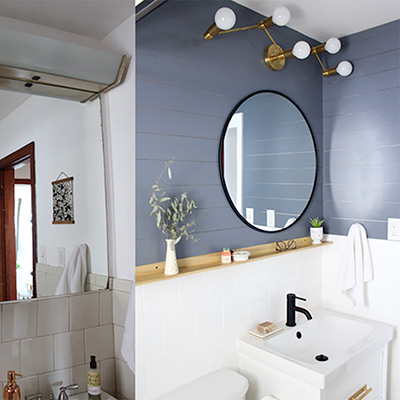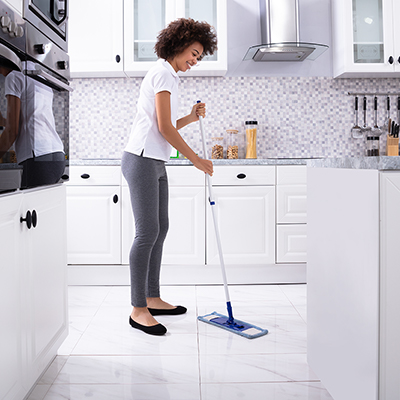Table of Contents
Choosing the Right Paint
Clean the Old Tile
Repair Tile and Grout
Sand Old Tile
Apply Primer to Tiles
Paint Tiles with Special Paint
How to Paint Tiles

Last updated December 26, 2024
Can you paint tile if your home has ceramic or mosaic tiles in a dated design or color scheme? For an inexpensive update, consider adding a new coat of paint. When finished properly, painted tiles look great in almost any room. You can paint on ceramic tile and almost every tiled surface in your home. However, painting tiles in a shower doesn’t usually work. This guide covers painting tiles in the bathroom, shower and other areas of the home and how to paint tiles effectively.
Difficulty:
Beginner
Duration:
Over 1 day
Choosing the Right Paint

Before you undertake this big project, take the time to choose the right paint for the job. While any kind of paint can technically be used, only some kinds of paint should be used for best results. Look for tile paint when possible.
- Enamel paint is either oil-based with alkyd resins or water-based with acrylic binders.
- One-part epoxy paint is an all-in-one paint that can be used right out of the can without any mixing.
- Two-part epoxy paint requires mixing two chemical components, a curing agent and a base, before it can be used.
- Two-process paints take two steps to apply: a bonding agent application and then a top coat.
- Can you paint tile with latex paint? While latex paint is common, it’s not recommended. It’s not long-lasting enough for most tile applications.
Both epoxy and enamel are efficient for painting tile floors with heavy traffic, though either may have an edge depending on the exact situation.
Clean the Old Tile

As you learn how to paint tile, you’ll need to do some prep work. Get started by cleaning the tile thoroughly.
Most tile is located in high-use areas such as kitchens and bathrooms where grime or soap scum can build up, so use extra care when painting tiles in a shower, for instance. Use a commercial cleaner and sponge to scrub tiles. Rinse with clear water and allow tile to dry.
If needed, apply a degreasing cleaner on kitchen tile backsplashes to make sure they are completely clean.
Repair Tile and Grout

Tile is durable and looks great for years. However, it can show signs of wear and tear. Before painting tile floors or walls, inspect the surfaces carefully. Use a putty knife to fill cracks and chips with caulk. Scrape away any excess and wait until repairs dry before moving to the next step.
Take time to repair the grout around the tiles as well. Little flaws can be fixed with a small amount of grout from a tube. Wear gloves and use your finger to rub in the grout. Wipe any extra off with a cloth. If the grout is in rough shape, it may need to be removed and replaced entirely.
Sand Old Tile

Most tile is finished with a layer of glaze for protection. For paint to adhere to tile, the glaze must be removed. Use a minimum of 100-grit sandpaper to hand-sand, or machine-sand tile with a sander before painting it. Gently rub the surface with sandpaper, taking care not to damage the tile's surface. When finished with sanding, use a damp cloth to wipe away any sanding grit.
Apply Primer to Tiles

After sanding the tile, get the area where you’ll be painting ready for painting. Use a drop cloth to cover the floor. Put painter’s tape on any surfaces and fixtures that you don’t want to get paint on.
Whether your goal is to update mosaic tiles for a hallway or painting bathroom tiles with a splash of color, one of the most important steps in learning how to paint tiles is using a primer. Primers hide unwanted colors and designs. When you’re painting tile, using bonding primer will help new paint adhere better to the tiles. It can also help keep the paint from chipping and peeling in the future.
Working on clean, dry tile, roll the primer evenly over the tiles. Use two coats if necessary, letting primer dry between coats before moving to the next step. If you are hand painting tiles, use a small paint brush to paint details onto the tiles.
As you’re applying primer and painting tile, work safely. Make sure the area is well-ventilated. Wear a mask, gloves and protective eyewear.
Paint Tiles with Special Paint

Painting tile adequately requires using special epoxy paints or tile paints. This paint is made to stick to tile. It is extremely durable and washable.
Use a roller to apply paint evenly to the tile as directed in the manufacturer's instructions. Make sure to paint grout as well.
- Use a brush to paint corners and edges.
- Use a roller for the main part of the painting surface.
- Be sure to load the roller cover, paint only onto still-wet paint, and start rolling at least six inches away from edges and corners.
- As you paint, overlap strokes a small amount and roll very close to the walls and corners to cover brush strokes.
- For a smoothing, blended finish, gently roll over the painted areas again with your non-loaded roller.
Let the paint dry for 24 to 48 hours so that it is dry and not tacky to the touch. Add a clear coat of polyurethane sealant if desired.
Add a Pattern

To give wall or backsplash tiles a refreshed look, you can add a pattern. Use a stencil when painting bathroom tiles or kitchen tiles.
- Find a stencil that suits the size of your tiles. Before you start adding the pattern to your tiles, practice stencil painting on a piece of cardboard.
- Start with a clean tile floor. Priming the tile will help the stencil paint stick to it.
- Plan the pattern so it will match the tiled space you want to paint. Use painter’s tape to cover the edges of the area.
- Begin stenciling on one of the edges. Work on one tile at a time. Lay the stencil on the tile. Use painter’s tape to secure the stencil. You can apply the paint with a brush or a sponge.
- The key to pretty stenciling is using the right amount of paint. Dab a little paint onto the stencil and tile at a time, adding more if you need to.
- When you’re done painting the pattern, allow plenty of time to let it dry. Depending on how you’re working, you may need to let one stencil dry before adding the next.
Drying and Curing

What’s the difference between drying and curing paint? Drying refers to evaporation of the water or solvents in the paint. It will feel dry to the touch. Curing, on the other hand, is when the paint has completed its chemical bonding with the surface. At this point, it will have reached maximum hardness.
While paint is curing, the surface shouldn’t be used. If it’s a floor, for example, it shouldn’t be walked on yet.
Read the paint can’s instructions for drying time between coats. Curing takes much longer and depends on the type of paint. Both drying and curing depend on the paint, the thickness of the layer(s), the ambient temperature and humidity, ventilation/air circulation and other exterior factors. Curing can take anywhere from four to 30 days.
Longevity and Maintenance

Now that you’ve finished painting your tile, it’s critical to take care of it so it’ll last longer. Painted tile isn’t going to be as durable as new tile. So you’ll have to take some precautions.
- Consider adding a layer of sealant to protect the surface, especially if it’s a floor.
- Have a routine for regular cleaning: sweeping, vacuuming, damp dusting and mopping.
- Put down floor mats or rugs on sections that get heavy usage.
- Wipe up any water as quickly as possible.
- Clean only with products suggested by the manufacturer. Harsh chemicals and even some natural cleaners may damage the paint or sealant.
Pros of Painting Tile

So can you paint tile? Yes, and knowing the pros and cons of painting tile can help you decide if this project is right for you.
Pros include:
- Painting tile is a budget friendly alternative to putting in new tile.
- It’s a DIY project that almost anyone can do. Painting tile is much easier than installing tile.
- You won’t have to take out the old tile or figure out how to dispose of it.
- Getting ready to paint tile includes making minor repairs to your existing tile, which can improve its appearance.
Cons include:
- Paint doesn’t last as long as the finish on tile. The paint you apply may come off over the years. Paint might not be the best option for high traffic tile, such as floors.
- Similarly, painting tiles in a shower, painting tiles in the bathroom, or painting any other tiles that get wet often may be inefficient.
- When you paint tile, the grout will be painted over, too. You’ll no longer see the contrast between the grout and tile.
- You need to do a thorough job of cleaning and repairing the tile before you get started.
- While the paint dries, you may not be able to use the room the tile is in.
If you aren’t in love with the tile in your home, you don’t have to commit to a costly replacement. When you know how to paint tile, you can give it a whole new look.
Ready to start painting tile floors or walls? The Home Depot delivers online orders when and where you need them.
Explore More on homedepot.com



























